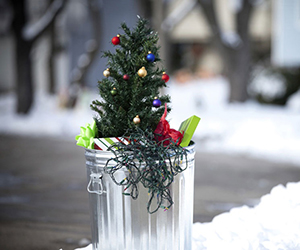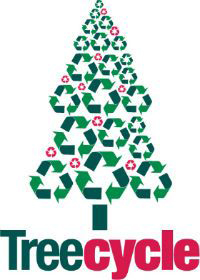Real Christmas Trees are Recyclable
By: National Christmas Tree Association
Posted on:12/27/2018Real Christmas Trees are biodegradable, which means they can be easily reused or recycled for mulch and other purposes. Real Christmas Trees are biodegradable, which means they can be easily reused or recycled for mulch and other purposes.

After the holidays, don’t throw your Real Christmas Tree in the trash or set it on the curb. Real Christmas Trees are biodegradable, which means they can be easily reused or recycled for mulch and other purposes. Here are some recycling options and tips on what to do with your tree after the holidays. Every community is different, but in general, you have these options:
Curbside pick-up for recycling: Many providers will collect trees during regular pickup schedules on the two weeks following Christmas. There are often requirements for size, removing ornaments, flocking, etc.
Take your tree to a drop-off recycling center: Most counties have free drop-off locations. Usually, you may take up to two trees to a drop-off location at no charge.
Yard waste: Cut the tree to fit loosely into your yard waste container.
Tree recycling/mulching programs: Tree recycling and mulching programs are a fast-growing trend in communities throughout the nation. Check with your local department of public works for information. They chip and shred the trees, then make the mulch available for use in your garden. Your hauler will notify you of pick-up dates in your area. Be sure to check with your local hauler.
Nonprofit pickup: Call for an appointment to have a nonprofit organization in your area pickup your tree. Some Boy Scout troops offer a pickup service for a small donation (often $5).

Other Recycling Options
Soil erosion barriers: Some communities use Christmas trees to make effective sand and soil erosion barriers, especially for lake and river shoreline stabilization and river delta sedimentation management.
Fish feeders: Sunk into private fish ponds, trees make an excellent refuge and feeding area for fish.
Bird feeders: Place the Christmas tree in the garden or backyard and use it as a bird feeder and sanctuary. Fresh orange slices or strung popcorn will attract the birds and they can sit in the branches for shelter. (Make sure all decorations, hooks, garland and tinsel strands are removed). Eventually (within a year) the branches will become brittle and you can break the tree apart by hand or chip it in a chipper.
Mulch: A Christmas tree is biodegradable; its branches may be removed, chipped, and used as mulch in the garden.
Paths for hiking trails: Some counties use shredded trees as a free, renewable and natural path material that fits both the environment and the needs of hikers.
Living, rooted trees: Get a rooted (ball and burlap or containerized) tree and plant it in your yard. (It's a good idea to dig the hole in the late fall while the soil is still soft, then plant the tree into that hole immediately after Christmas.) Living trees have a better survival rate in mild climates.
Recycle/Reuse Programs- Learn about the many ways that Real Christmas Trees are being recycled and reused in communities nationwide:
- Animal Enrichment at Busch Gardens and other Zoos
- Salmon Spawning - Northwest Oregon
- Rebuild Sand Dunes after Hurricane Sandy - Midway Beach, New Jersey
- Rebuilding an Island - Easton, Maryland
- Wildlife Habitat - Porter County, Indiana
- Mulch for Planting - Georgia
- Dune Restoration - Gulf Shores, Alabama
- Rebuilding the Louisiana Coastline - Jefferson Parish, Louisiana
- Home for the Herons - Cook County, Illinois
- Giving Back to the Community - San Diego, California
- Improving Fishing Areas - Keene, New Hampshire
- Building Better Parks - Clarksville, Tennessee
- Fueling Our Nation's Industry - Tomahawk, Wisconsin
- Turning Trees into Electricity - Burlington, Vermont
**Important: Never burn your Christmas tree in a fireplace or wood stove.
 Sign In
Sign In
 Sign In
Sign In
